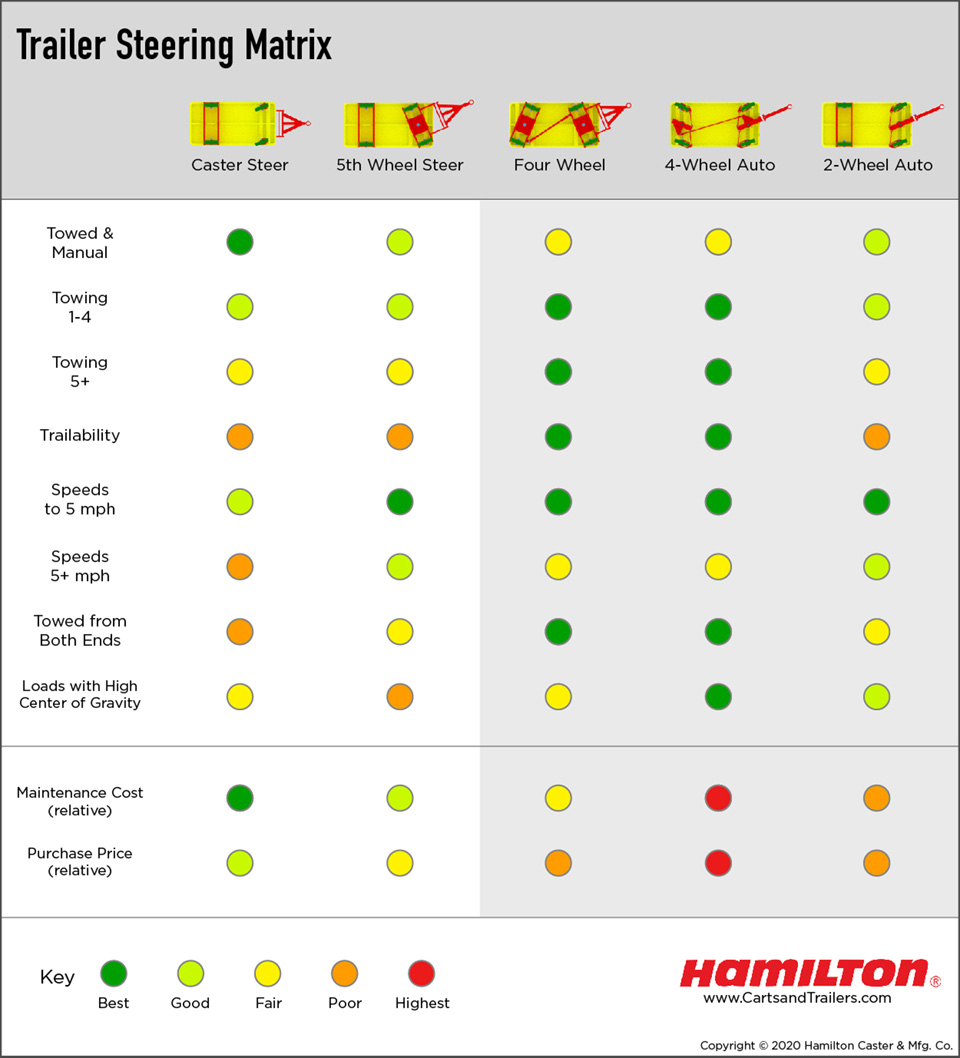“What type of steering system do I need for my trailer?”
It’s one of the most common questions we get from our customers.
A lot of people assume fifth-wheel steering is the only option. If you know anything about Hamilton, you know we do it all. And we’re here to guide you at every turn. Here’s an overview of the different options Hamilton offers for one of the most important factors that can make or break your trailer application: Steering types. All are customizable for your specific needs.
Why trailer steering matters
It’s crucial to your cart’s performance and lifespan, affecting everything from stability and tracking to pulling force. That’s why we’ve created a handy Trailer Steering Matrix Chart below to help you better compare factors like trailability, stability, speed and cost.
Caster Steer Trailers
- Steering style: Two swivel casters at one end, two fixed wheels at the other end
- Features:
- Simplicity
- Excellent stability
- Most economical
- Allows for both towing and manual movement
- Popular Applications:
- Wherever the trailers are to be both towed and pushed by hand.
- Warehouse and manufacturing where trains of trailers are towed, and trailer is left with the product at point of use.
Fifth Wheel Steer Trailers
- Steering style: A single pivot point in front, two fixed wheels in the back (like a child’s wagon/semi trailer)
- Features:
- The industry “standard” for its versatility
- Great for power towing (singularly or in trains)
- Can be towed at higher speeds than Caster Steer
- More economical than Four Wheel Steer
- Good stability
- Popular Applications:
- Applications in which trailer does not need to be positioned by hand
- Heavy loads
- Cost is a factor
- Pulling a single trailer
Four Wheel Steer Trailers
- Steering style: No fixed axles—both axles pivot for steering and are connected to each other by a tie rod
- Features:
- Pricier than Two Wheel Autor Steer, due to more sophisticated engineering
- Tracks similar to a non-auto Four Wheel Steer
- Popular Applications:
- Where aisle space is limited
- Best for towing long trailer trains or when you need reversible towing (towing from either end, not backing up)
Auto Steer Trailers
In general, Automotive Steer Trailers are designed with fixed running gear under all load corners as you turn (as opposed to Fifth Wheel Steer Trailers, where the entire axle assembly turns). Below are some common types. All offer maximum stability.
Two Wheel Auto Steer Trailers
- Steering style: Mimics car steering
- Features:
- Tracks similar to Fifth Wheel Steer
- Less expensive and easier to back up than Four Wheel Auto Steer
- Smart choice for maximum stability
- Popular Applications:
- Applications where the load may have high center of gravity
- Pulling a single trailer
Four Wheel Auto Steer Trailers
- Steering style: Front and rear steering of a car, connected by a tie rod to coordinate tighter, more accurate turns
- Features:
- Pricier than Two Wheel Auto Steer, due to more sophisticated engineering
- Offers the maneuverability of Four Wheel Steer with the stability of Auto Steer for maximum performance
- Popular Applications:
- Applications where the load may have high center of gravity
- Applications where you are pulling multiple trailers
- Applications in which trailability is an important factor
To learn more about Hamilton steering options, click here.
